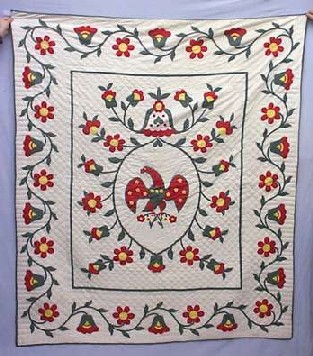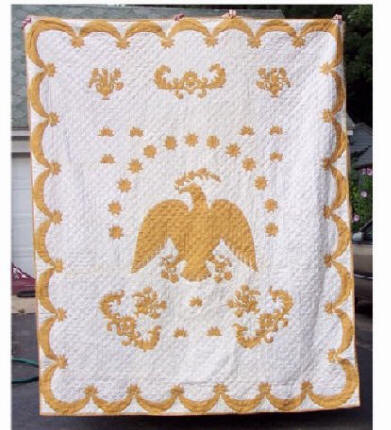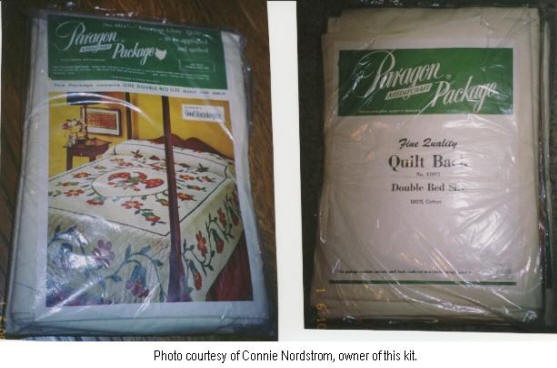Kit quilt circa 1950s, Made by Marsha W.Tyler-Ronquist
(See larger picture and link to actual kit instructions below.)
Inparentheses are pagenumbers for pictures of illustrative quilts found in America's Quilts and Coverlets byCarleton L. Safford and Robert Bishop, 1985 edition. This book is commonly found in public and quilt guild libraries ifyou don't own it, but many of you will. Patriotic symbols that we see onquilts can change over time. Yet symbols from the past remain with us too,such as the eagle, Liberty Bell, Statue of Liberty, President'sfaces, Uncle Sam, large Vs for Victory, flags, shields, words like union,confederacy, abolitionists, liberty, E. Pluribus Unum, and plenty of stars inred, white and blue fabric. Lately, we have seen the NY skyline, Twin Towers,firefighters and police. Women began putting their needle to the cloth to do the work of their tongues at the same time industry was turning to machines to ease the labor. Prior to the industrialization of America, women were more allowed to give their opinion and make decisions about the house and farm because they had such an enormous influence on running the farm and the home. When they were relegated just to the concerns of the home, they lost their power to have their opinions heard and concerns spoken out loud. Naturally, women's thoughts, and feelings of compassion and patriotism, were still quite active and wanting to be heard. It was their needlework they turned to, to make their voices heard.
In the late 18th century and early19th century, we find the bald eagle and the face of George Washington mostoften, with the flag gaining in popularity as time goes on. The American flag'sdesign that we know today was not acknowledged as the official flag until June1777. For several years after that, other flag designs were still in use.
Embroidery (p. 66) whitework, andcandlewicking would have been the first ways women spoke of their patrioticpride through their quilts. A whitework quilt could simply be an all whitequilt, with intricate quilting designs, and/or corded and stuffed. It could alsobe candlewicked, a form of embroidery using wide white cotton embroidery threadpulled into loops, sometimes cut and washed to form a fringe or pile on top ofthe quilt (pg. 278). Eagles and stars were favoriteFederal period motifs. The American bald eagle was adopted as the official birdof the US on June 20, 1782, but the search for a symbol began six years earlier.Three men -- Benjamin Franklin, Thomas Jefferson and John Adams --- were chosento determine the design for the Great Seal. Seven revisions later, the Seal wassealed (sorry, I couldn't pass that one up <g>) (pg. 273). Americans lovedbirds as their former Mother Country did, but the eagle was not meaningful inEngland's heritage and therefore made the perfect bird to symbolize USindependence, strength and soon-to-be freedom. The earliest quilt I found witheagles printed on it is unusual. It's entirely hand block printed with indigo onwholecloth linen. There are two eagle designs and Masonic symbols formingmultiple borders around a center oval, with Thomas Jefferson's upper bodyinside. Red dye was used to stamp a shield on the eagles' chests. The maker andorigins of this rare circa 1800 quilt are unknown. Woven coverlets bordered byeagles form a beautiful needlework design (pp.253, 268, 272, 274, 275). AfterJacquard invented his loom that could weave curved designs, the eagle became afrequent motif, if only in the corners (pg. 252). Eagles on quilts increased after theWar of 1812 and are frequently seen on them from then on. The eagle, often withhis shield, ribbon flowing from his mouth, and an olive branch and arrows in hisclaws, is appliquéd quilts (pp. 154-5). The earliest dated one I have found wasmade in Montville, CT, in 1807 (pg. 150). The appliquéd is only a narrow stripof the same fabric to make an outline of the entire top, forming the eagle,bough border, shield, and so on. It looks like embroidery more than appliqué.
 Kit quilt Circa 1960s Kit quilt Circa 1960s
Owned by Judi Fibush, near Sacramento, CA.
* Thank you to Shirley Mc Elderry, Ottumwa, IA, for the followinginformation:
" Cuesta Benberry once stated that this kit was the 'epitome of quilt kits' and I think she's got it. This kit had 'reproduction prints' and a reasonable facsimile of the old Turkey Red fabric. It was such a good kit that a quilt made from it fooled authors Safford and Bishop in the frontispiece of America's Quilts and Coverlets, where it is pictured and and described as: Appliqué Quilt, c. 1860, Pennsylvania.
"The first publication of this pattern was in Good Housekeeping Magazine,September 1961. It is described as: 'American Glory Quilt No. 1147. A trulybeautiful early American Design inspired by an antique in the PhiladelphiaMuseum. Stamped for appliquéing and quilting on eggshell colored percalebackground. The color fast appliqués are calico green and yellow prints andreds. Double and single bed sizes.' Many of Paragon's kits were offered forsale in LeeWards and Herrschner catalogs.
However, I've never seen thisparticular kit advertised in them."
View Paragon kitat end of article.
Never far behind the fad of the daywere textile designers, even in Europe and Asia, printing people and symbols ofAmerican patriotism on fabric. Large handkerchiefs, 30"x 30" plus,printed with engraved plates allowing tiny details to be printed (pg. 121), sothat an important official's complete speech would be printed on cotton, or anews story about them. This was done when Washington died in December 1799(pg.120). Women put historical handkerchiefs into their quilts. Usually theywere placed in the center as the medallion, but sometimes several were sewntogether to form the quilt top. Centennial commemorativehandkerchiefs, presidential campaign textiles, and other grand fair kerchiefs,are more often displayed this way in quilts then the early ones. TheSpanish-American War, 1898, brought forth patriotic textiles made into quilttops, which can be confused with WWI textiles. Both were usually made of silk,not rayon like those made for WWII. Flags from nations all over the worldusually decorated the Spanish-American War textiles, unlike those made for WWI.I have seen more pillows and hankies with a sentimental theme than flags on WWItextiles. Toiles, made abroad, depictedcurrent events or anecdotal scenes bursting with patriotism using Americanpresidents, dignitaries, mythological figures and symbols of America. One of thebest known is called, The Apotheosis of Washington and Franklin, anEnglish copperplate engraved circa 1780 (pg. 50). It does not have an eagle onit. In 2001, Barbara Brackman reproduced her version of the Apotheosismonochrome for her Moda line. One enduring eagle print began in the mid-19thcentury as a colorful chintz furnishing print. It had small eagles with spreadwings, a shield, and a ribbon flowing with stars arching above, all inside awreath of flowers. I have found two original colorways. One had a dark brown andecru background with dark green and orange floral garlands, and the other had atan ground with motifs in rose, blue-green and brown. This chintz was used forwholecloth quilts, upholstery, and draperies, and was cut up for patchwork. Inthe 1990s, Moda reproduced it for quilters. Mid-19th century Baltimore, Marylandalbum quilters paid tribute by appliquéing eagles, flags, shields, soldiers,and banners describing battles, onto their quilt blocks (pp 148-9, 180-1). Oftenthey were made to honor a particular war hero. The log cabin house was thesymbol of President William Harrison's campaign. He stood for the common man inthe antebellum period. During the Civil War, fewer quilts survived, but the flagappears to be the chosen symbol more often than others, and it remained popularinto the next century (pp. 138-142). Eagles, shields and flags continue to beseen in many styles of album quilts. Ohio, Pennsylvania, and surroundingstates, were known for making quilts of four large eagles appliquéd with theirheads generally pointing inwards (pp. 154-5). Sometimes there was a circular orstar motif in the center or at the corners. Orange, red, yellow, brown or darkgreen, and white were the usual colors. This style was seen throughout the 19thcentury and early 20th century, but it wasn't necessarily in these colors. ThePennsylvania/Ohio colors date the quilt after 1880 (pg. 146 has an unusual one). Embroidered flags are found on crazyquilts made at the end of the century, but seldom does one see an eagle.Patriotic quilts made in the 20th century are decidedly different then thosejust discussed. One element that stands out is the use of solid fabrics, whetherit is pieced or appliquéd. Both were popular. Appliquéd pictorial quilts werefrequent entries into the Century of Progress quilt contest at the 1933 ChicagoWorld's Fair, including symbols of America's freedom and history. Many eagle quilts were made fromkits. Kits were available from early 1900 into the 1960s, but the 1920s and1930s were their most popular years. Stars were often arched above the eagle'shead or they encircled it. TheColonial Revival period caused kit makers to use small calico prints,reminiscent of the past. Solid fabrics were also popular, especially in the1950s and 1960s, when yellow-gold solid colored eagle kit quilts are seen.
Kit quilt circa 1950s
Made by Marsha W. Tyler-Ronquist

Marsha found this quilt kit at an estate sale. She used the machine to appliqué and quilt this kit. It is by Paragon Needlecraft #01128, titled, "American Eagle Quilt." It was sized for a double bed. All the gold and white fabric is 100% cotton in 36" wide.
Marsha said, "It was exciting finding a kit that was so complete. I found two appliqué pieces missing, but the kit also had three 3-yard pieces (nine yards total) for the backing. I matched the backing as closely as I could with one new 3-yard piece and placed it in the center of the other two 3-yard panels on the back; I used one of the backing pieces for the two appliqué pieces. This also gave me enough to make the binding match the front for color. I have sent a letter to Woman's Day." Click here for American EagleQuilt kit instructions.
|
Faster and easier to make thenappliqué, red, white and blue patchwork quilts of flags, stars, airplanes, orVs flags were common during the war years, when quilting for fun waned as thedepression hit and women had to fill their soldier husband's shoes. Purpose anduse were primary, but sentiment spoke loud and clear in support of their husbandor son in the military (pp. 138-142). Safford and Bishop's book pictures a red,white and blue start quilt that looks like it was made in the 1940s, but it'sdated 1855! (pg. 105). Each is made of 8-pointed diamonds in a red, white andblue stripe, with red stripes meeting in the middle. It is sashed in red andblue with red, white and blue narrow strips for a narrow border. Feedsacks and flour sacks joined thepatriotic theme, too. Patricia Cox's quilt Star Coverlet, pictured in "AmericanQuilt Classics" by Cox and Maggi M. Gordon (pg. 131), is made of fourlarge flour sacks sewn together to form the top. It looks like a complete quilt,border and all. 8-pointed stars in red, white and blue are inside a singlewedding ring style of sashing with a wide wavy border design. The stars are madeof three different patriotic prints on a white background, with a tiny motif,probably stars. It's dated 1930, but if it were in patchwork it would ring trueof the WWII quilts to be sure. Interestingly, the backing is a print of the samefour sacks but with red as the primary color. Certainly there were other patrioticquilts styles made, embroidery (pg. 455), redwork (pg.141 insert), crazy quilts(pg. 302), Desert Storm and 9-11 quilts. And there will be more to come. Pieceto you and those you quilt with, live with, and love.

Next:Eagles on Quilts and Eagle Quilt Kits
Other articles on patriotic expression through quilts that you will enjoy arewritten by Anne Johnson on her Web site: History of Quilts: Patches From thePast:
Patriotic, Political andCommemorative Quilts , QuiltedReactions to Desert Storm ,
Blue Star Banners andQuilts. |